Law provides solid support for TCM development and governance over past 5 years
The Law on Traditional Chinese Medicine has guaranteed the inheritance and innovative development of traditional Chinese medicine (TCM) in a law-based, healthy and orderly manner and has laid a solid foundation for establishing the TCM governance system, said Yu Haiyang, director of the department of policy, regulation and supervision of the National Administration of Traditional Chinese Medicine (NATCM), at a recent news conference.
The fundamental law on TCM, effective on July 1, 2017, has set up comprehensive institutional arrangements for TCM services, protection and development, talent training and scientific research, thus creating a well-rounded legal system, alongside other supporting measures introduced over the past five years, according to Yu.
Simplified procedure for setting up TCM clinics
The Law on Traditional Chinese Medicine stipulates that a TCM clinic may be set up after its name, address, scope of diagnosis and treatment, and staffing are filed with the competent authorities of TCM under the people's government at the county level of the place where the clinic is located.
In line with the law, the then National Health and Family Planning Commission released a regulation to guide TCM clinic registration on Sept 22, 2017, followed by technical standards and other guidelines introduced for such clinics. As of June 2022, there are 28,280 registered TCM clinics nationwide.
The change from an approval system for new TCM clinics to a registration system reflects the spirit of deepening reform through efforts to streamline administration, delegate power, and upgrade services, and is a key institutional innovation, said Zhao Wenhua, deputy director of the NATCM's department of medical affairs.
Zhao also said the NATCM will guide local TCM authorities to exercise supervision and establish measures, such as keeping a record of malpractice, in order to regulate the development of TCM clinics.
Improved TCM service network at community level
The Law on Traditional Chinese Medicine makes it clear that a TCM department should be set up at health institutions funded by the government, such as general hospitals, maternity and child care institutions as well as at qualified specialized hospitals and community health service centers.
Thanks to policy support, grassroots-level TCM service capacity has been remarkably improved in recent years. By the end of 2020, there were36,300 TCM clinics nationwide, with TCM services available at 99 percent of community health service centers, 98 percent of township health institutions, 90.6 percent of community health service stations, and 74.5 percent of village clinics.
From 2012 to 2022, the central government provided financial support to 36,700 TCM clinics, and by the end of the year, all community health service centers and township health institutions are expected to have their own TCM clinics.
Liu Hong, director of the Puhuangyu community health service center in Beijing's Fengtai district, said that the center's TCM services have greatly improved in recent years and that TCM physicians account for half of the center's practitioner team. As a result, the center is able to provide various TCM treatment and health management for the community's residents.
Backed by a series of supportive measures, China has gradually built an extensive TCM service network at the community level, led by county-level TCM hospitals, with heath institutions at township level and below playing a major part, and being further supplemented by privately-run service providers.
Zhao said more efforts will be made in the 14th Five-Year Plan (2021-25)period to address TCM development challenges, including a lack of quality medical resources, regional disparity, urban-rural gaps, and a limited grassroots-level service capacity.
Equal emphasis on Chinese medicine and Western medicine
The incorporation of Western medicine is a major feature of TCM development in China. The Law on Traditional Chinese Medicine includes the principle of attaching equal importance to TCM and Western medicine, an approach further underpinned by a new law on physicians that came into force on March 1, 2022.
Furthermore, other measures were also taken to combine the use of the TCM and Western medicine, such as conducting joint diagnosis and treatment in clinical practices, making TCM a compulsory course for undergraduate programs in clinical medicine, and piloting a nine-year educational program featuring the integration of TCM and Western medicine.
Zhao added that other efforts have been made to build a national TCM talent pool in response to major public health events and epidemics, a national TCM team for epidemic prevention and control, and to encourage a TCM approach in research and medical training.
- Top legislature schedules session for December
- China's top legislator holds talks with president of Luxembourg parliament
- China's top legislator meets with French president
- China, Maldives pledge to enhance exchanges between legislative bodies
- Senior Chinese legislator meets Portugal's PSD delegation



